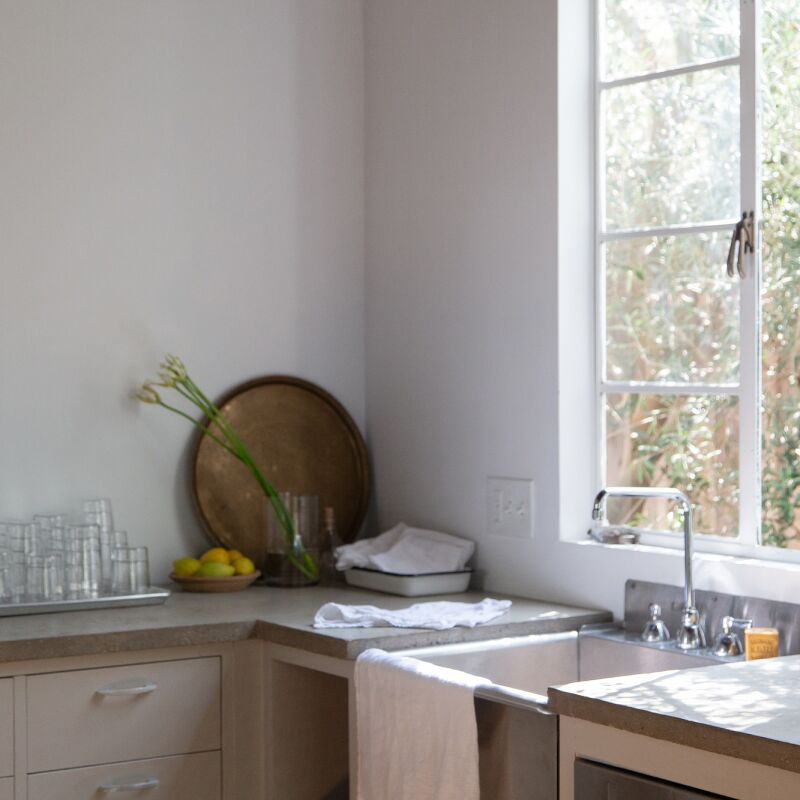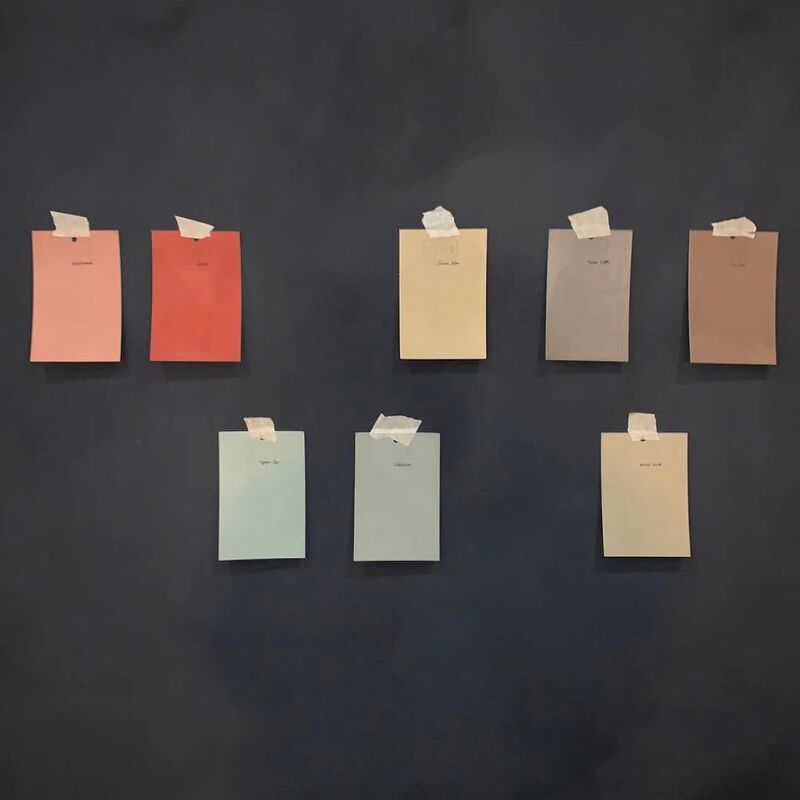I’ve long loved concrete floors. I like their zero-maintenance appeal, their industrial look that gets better with time, and—though they work well with radiant underfloor heating (see our Remodeling 101 on the topic)—I even like the feeling of a cool floor underfoot, especially when temperatures rise.
But I’ve recently found a flaw in concrete floors—something that had never occurred to me until I attempted to remediate the situation: If your concrete floors are stained, their color is quite literally “set.” In my apartment, that’s an inconsistently applied, dusty red. If you want to change it, you’ll need to put in either major money or elbow grease.
To wade through the options, I talked to Anthony Zamora of C Rock Finishing in Oakland, California—here’s what I learned.

How easy is it to change the color of stained concrete floors?
Not very. “Concrete is like a big rock sponge,” Zamora says. “Before it has anything on it, it wants to soak up everything.” Meaning that whatever has already been applied to your concrete floors has fundamentally changed the material and will affect coloration going forward. This is a generalization, of course—but when floors are “stained,” or more accurately, treated with a penetrating sealant, the color has been absorbed to an unknown depth.
To change the color, we’re covering the two most common solutions here: You can re-stain the floors (by applying a new penetrating sealant) or paint them (by applying an industrial coating). Other options include staining and then polishing your floors (which achieves a different effect than just re-staining) or covering them entirely with a new material, like a microtopping or concrete overlay.

How can I re-stain my concrete floors?
To start, you’ll need to have the existing surface mechanically ground down, both to prime the concrete to accept a new stain and to remove as much of the offending color as possible. “You can’t control how much stain permeated the concrete in the original process,” Zamora says.It could be superficial and come off fairly quickly, or it could have permeated as deeply as half an inch down, which means it’s not going anywhere. You’ll need to mechanically grind your floors to determine your next step.

What does it mean to mechanically grind the concrete?
You need to use something harder than concrete in order to grind it down, explains Zamora, which usually means a substrate like metal, ceramic, or resin that’s been impregnated with diamonds. “Diamonds are so strong that they can actually cut up the surface of the concrete.”
Can I mechanically grind the floor myself?
If you’re imagining going over your floor with an electric hand sander (like I did), don’t: “It’s a messy process,” said Zamora, “and the dust is dangerous. If someone is going to do this themselves, they must do a ton of research first and follow best practices to stay safe.” To start, you’ll need to rent a mechanical grinder plus a large HEPA vacuum to filter the toxic particulates out of the air. These rentals will run you about $1,500 together, Zamora estimates. You’ll also want to be sure the particulates stay away from anything you’ll be living with—so all belongings and furniture must be securely covered, or, ideally, removed before work begins. (It’s obvious, but there’s no harm in stating it: People and pets should stay far away.)

The concrete has been mechanically ground. Now can I stain my floors a new color?
Sort of. “The stains will interact the way they will,” said Zamora. “You cannot control it.” Meaning, you’ll always see remnants of what came before. If the floor was unintentionally stained early in its life—like the bucket ring the contractor left while staining my floors red—that mark will never go away (a feature insiders call “ghosting”). Color-wise, your best bet is to stain the floor a darker color—for instance, very dark gray or black—and you’ll achieve 80 to 90 percent coverage in the best-case scenario. In my case, Zamora says, the floor “will always have an echo of red in it,” no matter how dark a stain I choose.

Staining won’t work for me. What if I want a uniform look?
If you want a uniform look, consider coating your concrete floors with an industrial solution like epoxy or polyurethane.
Can’t I just paint over it myself?
Zamora points to the garage and concrete floor coatings sold at home improvement stores and says they can be applied at home with mixed results, but emphasizes that these are not the same solutions that a concrete professional would use. “If you have a small closet or laundry room to cover, these should work fine,” he said. “If you’re talking about your living room, where you want a nice finish and one that will hold up over time, avoid the DIY painting route.”
Joan Barton of Dirty Girl Construction in LA gave us the following advice: “Refinishing concrete to a perfect, polished showroom type of floor is very time-consuming, but less expensive than epoxy and something that a DIY-er who has the time and energy can achieve if they follow the right steps,” she said. She’s had artist friends paint their floors with good results; she reports that another perfectionist friend said, “‘Oh my god, never again!’—and that’s from a designer who likes to DIY as much as possible.”
Note: We’ve heard of folks painting over their concrete floors with standard wall paints, but this is not recommended. “You’ll be peeling paint chips off your shoes and chair legs and you’ll be constantly touching up the paint,” Barton says. “If you’re going for something rustic, that could be OK—except the paint chips on shoes part.”

How much would it cost to have my floors redone professionally?
Zamora laid out a few rules to keep in mind when considering the pricing of concrete floor refinishing.
First, “everything we do is based on economies of scale,” he said. “The larger the project, the lower the price per square foot.” Zamora estimates that for a 2,500-square-foot space or larger, concrete refinishing is about equal in price to having tile or carpet installed. But for a space any smaller, the cost per square foot might be between 50 and 200 percent more expensive.
Second, pricing is dependent on the space. One large rectangle will be much more affordable to refinish than five rooms that add up to the same square footage. The more edges, corners, closets, etc., the higher the cost.

How much would it cost to have a penetrating sealant re-applied?
It depends on the look you’re after, but a basic, high-quality finish on a 1,000-square-foot space would cost between $6,500 and $12,000 in the San Francisco Bay Area, Zamora estimates. “Los Angeles would be a little bit cheaper,” he says, as would most other locales in the US. (You’ll need to solicit quotes in your own area, but if you don’t live in San Francisco, at least now you’ll avoid sticker shock.)
Remember, Zamora says: In both cases, a 200-square-foot room is not going to be 80 percent cheaper just because it’s 80 percent smaller. Minimums do apply for concrete refinishing.
How much would it cost to have an industrial coating professionally applied?
A basic finish on a 1,000-square-foot space would cost between $8,000 and $15,000 in the Bay Area, Zamora says.
One note: If you’re only looking to refinish a garage floor, there are cheaper options than what’s outlined here. Zamora estimates that a refinishing business in the Bay Area might charge as little as $1,800 to cover a 400-square-foot garage with an industrial coating (the kind meant for garages, with small flakes inside for traction—not something you’d want in your living room).

Can I hire a pro to grind the floors and I’ll do the staining or coating myself?
“This is a great question,” said Zamora, “because people often misunderstand the pricing.” The surface prep, including grinding, is the bulk of the cost with concrete refinishing. “Say I quoted $6,000 to restain a floor,” he said. “If you only want me to do the prep work, it would still cost you $5,000.”

Summary
“If you have the budget, hire skilled installers,” Zamora says; your stain or coating can last between 15 and 20 years with proper maintenance. “If you don’t have the budget, and you’re going to DIY, do everything you can to follow best practices from beginning to end, so you don’t have to relive the process again later.”
After all I’ve learned, I’d have an epoxy coating professionally applied if I had the budget. But I’m dealing with the spotty red floors for now, and researching hardwood.

For more solutions with paint, see:
- Remodeling 101: 6 Kitchen Cabinets Transformed with Paint
- DIY: Painted House Numbers
- Paints & Palettes: Spring Color Scheme
Frequently asked questions
Can the color of stained concrete floors be changed?
Yes, the color of stained concrete floors can be changed. There are several methods available to alter the color of stained concrete, including acid staining, water-based staining, and concrete dyeing. These methods allow for the application of new colors to the existing stained concrete surface.
What is acid staining for concrete floors?
Acid staining is a technique that involves applying acid-based chemical stains to the concrete surface. The acid reacts with the minerals in the concrete, creating unique and variegated color patterns. Acid staining provides a natural, mottled look and is available in a range of colors.
What is water-based staining for concrete floors?
Water-based staining is an alternative to acid staining that uses water-based dyes or stains. These stains penetrate the concrete surface and provide a more consistent and predictable color outcome compared to acid stains. Water-based staining offers a wider range of color options and can be easier to work with.
Can I change the color of stained concrete floors myself, or should I hire a professional?
Changing the color of stained concrete floors can be a DIY project, especially if you have experience working with concrete and staining materials. However, for best results and to ensure proper surface preparation and application, it is recommended to hire a professional contractor who specializes in concrete staining.
What are the factors to consider when changing the color of stained concrete floors?
When changing the color of stained concrete floors, consider factors such as the condition of the existing stained concrete, the desired color outcome, the type of stain or dye being used, and the level of expertise required for the chosen method. It's important to properly clean and prepare the surface before applying any new color.
Can the color change be applied to both interior and exterior concrete floors?
Yes, the color change can be applied to both interior and exterior concrete floors. However, it's important to select staining products that are suitable for the specific conditions and requirements of the area. Exterior concrete floors may require additional protection against UV rays and weathering.
How long does the process of changing the color of stained concrete floors take?
The time required to change the color of stained concrete floors depends on various factors, including the size of the area, the preparation work involved, and the staining method used. It can typically take a few days to complete the process, including cleaning, etching, staining, and sealing.




Have a Question or Comment About This Post?
Join the conversation